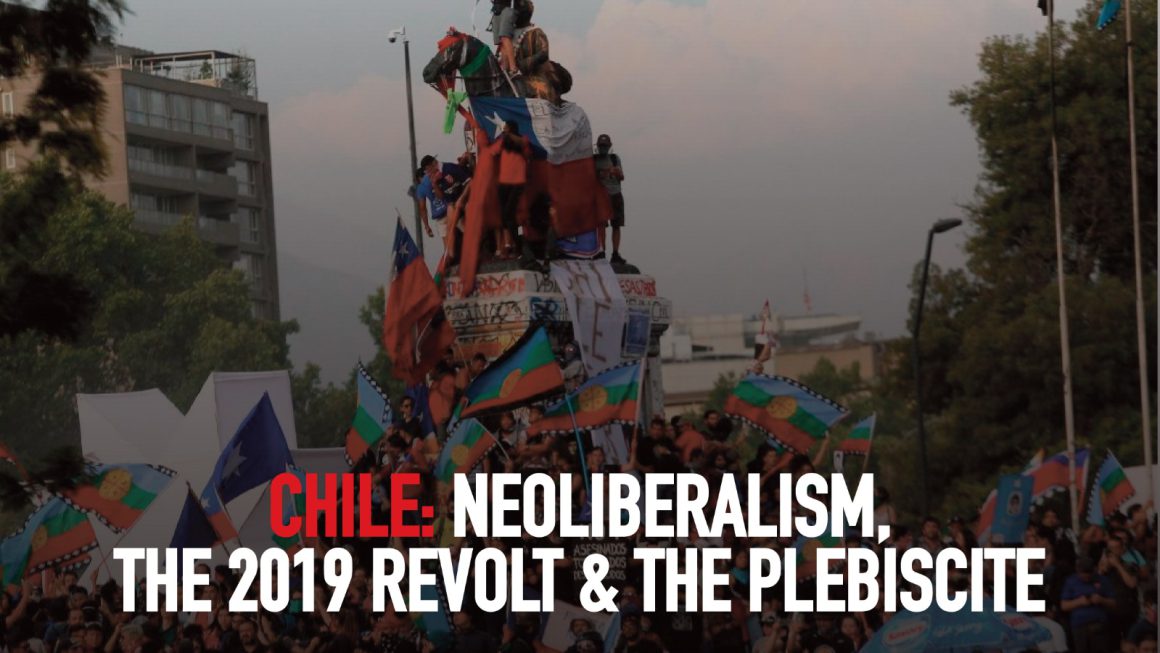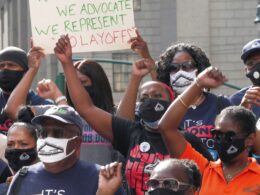By Josafat Arrieta- Alternativa Socialista (our sister organisation in Mexico)
For years Chile was seen as a regional success story of the neoliberal economic model. As the country with the highest Human Development Index (HDI) in Latin America, it has always been considered by advocates of neoliberalism as an example to follow. However, behind the positive economic indicators there was hidden a hard truth: Chile was also one of the countries with the largest inequality gap in the region.
On October 25th, Chile held the plebiscite that defined the future of the constitution inherited by the military dictatorship. The resounding result in favor of a new constitution was the most recent expression of the movement that began on October 18, 2019. The social explosion has shown that Chile was far from being the neoliberal paradise that the government’s narrative tried to sell to the world for 47 years. The new constitution could be an important step towards a new Chile, but this will only be possible on the basis of a perspective of mass mobilization and organization for a break with the fundamental pillar of the Pinochet constitution, the capitalist system.
A world to win
“Hasta que la dignidad se haga costumbre!”: (Until dignity becomes the norm) The words that Patricio Manns dedicated to Bautista van Schouwen, leader of the Revolutionary Left Movement (MIR) in the 1970s, became the cry that ran through Chile in the last months of 2019. Under this banner were the great demands of the Chilean working class: free public education and healthcare, better working conditions, respect for the rights of indigenous people, a fair pension system and, above all, a new constitution.
The Chilean mass movement was part of a cycle of mass mobilizations that shook different regions of the world, but which had an even greater echo in South America. During those months we witnessed how in Bolivia the masses defended themselves from a coup d’état promoted by the Creole right wing, the bourgeoisie and the armed forces, while in Ecuador and Colombia the workers also took to the streets together with the indigenous peoples in the struggle for a dignified life. This showed the great contradictions and inequalities present in the region and opened a new chapter in the class struggle in Latin America.
The myth of neoliberal success
For years Chile was seen as a regional success story of the neoliberal economic model. As the country with the highest Human Development Index (HDI) in Latin America, it has always been considered by advocates of neoliberalism as an example to follow. However, behind the positive economic indicators there was hidden a hard truth: Chile was also one of the countries with the largest inequality gap in the region.
The data indicates that in that country the richest 1% concentrate 26.5% of the national wealth, while the poorest 50% barely manage to reach 2.1%. This is a figure that has moved in favor of the ruling class during the Covid-19 health crisis, which has only aggravated the fragile situation of the Chilean working class.
Neoliberalism was imposed here through the dictatorship of Augusto Pinochet (1973–1990) and became the first laboratory where the Chicago School economists would apply their policies.
Through the so-called “Shock Doctrine” and the “Seven Modernizations”, promoted by the “Chicago Boys”, the first stage of neoliberalism took place in Chile. The crisis of 1982 forced a momentary return to Keynesian measures until 1985, when the Secretary of Finance Hernán Büchi would carry out a new series of reforms which again took up the proposals of the Chicago Boys.
The neoliberal measures of these two periods in Chile are in essence very similar to those applied in the rest of the world, although it is true that there are aspects where the hard hand of the military regime favored them to be carried out in a more profound way. Among them we can highlight the following:
— Privatization of all state-owned companies leaving the industry completely in the hands of the private sector.
— Reduction of public spending, especially in the area of social spending.
— Privatization of the pension system, which was left in the hands of the so-called Pension Fund Administrators of Chile (AFP).
— Reduction of the tax burden to favor and attract private initiative
These conditions would be maintained even after Pinochet left power in 1990, during the so-called period of transition to democracy — in which Pinochet would remain as Supreme Chief of the Armed Forces — and the first two decades of the 21st century.
Despite the fact that since 1990 Chile has been governed by five presidents from four different political parties, none of them was able to push through economic measures that would counteract the legacy of the dictatorship and substantially favor the working class. Even during the two terms of Michelle Bachelet, who was considered part of the progressive wave in Latin America, there were no concrete advances in the key issues reflected in the demands of the “Chilean spring” of 2019.
But what are these issues? One of the main ones is the Chilean educational system, which is managed by the main business associations in the country. According to data published by the University of Chile, 47% of basic and secondary education institutions are privately run, while 70% of the financing of higher education, including public universities, came from private hands. However, this has not translated into quality education, given that the Chilean education system is one of the worst ranked in South America and among the OECD countries. Paradoxically, it is also classified as one of the most expensive in the world.
The lack of a free public education system has resulted not only in a high number of people over 20 years of age with unfinished schooling, 4.7 million in total, 25.1% of the country’s population. It has also led to a blatant socio-economic segregation between schools, notably favoring more affluent students.
On top of this are the demands for decent working conditions. During 2019, according to data from the National Institute of Statistics, the average monthly income of a Chilean household was $573,964 Chilean pesos (USD $846 approximately). However, of that total, an estimated 20.23%, or $116,130 Chilean pesos (USD $206.5 approximately), was spent on services and public transportation.
Likewise, it is necessary to emphasize that the Chilean working day, 45 hours a week, was one of the longest among the OECD countries and the region. Although there is now an initiative tabled by deputies of the Communist Party of Chile, which was approved in the Chamber of Deputies in October last year, it remains frozen awaiting discussion and approval in the Senate.
Then there is the pension system, which since the time of the dictatorship has been in the hands of the AFPs. These are private institutions that manage the savings that are deducted from workers’ salaries to finance a pension.
2019: “Chile Despertó”
Given the conditions listed above, the announcement of a 30 Chilean peso ($0.04) increase in the price of the Santiago subway would set off the time bomb that had formed in Chile. What began with a call from high school students to not pay for the metro became a struggle of millions of Chileans fighting for a better future, with the organized working class playing a prominent role.
In the weeks following October 18, the initial popular discontent was fueled by the Chilean government’s harsh response to the mobilizations. The deployment of carabineros (Chilean Military Police) to repress the protests resulted in a total of 34 deaths, according to official figures, and, according to the reports of the Chilean National Institute of Human Rights, 3,557 people were injured between October 2019 and March 2020.
In addition to police violence, multiple reports of sexual violence against women protesters by carabineros sparked massive outrage and mobilized Chilean feminist collectives, which coincided with a new green wave developing in the region. Likewise, the age-old struggle of the indigenous peoples in defense of land and life, especially that of the Mapuche people, was once again placed in the public eye, since they were also victims of the police violence and the demonstrations of the extreme right.
The Constitution and the plebiscite
The mobilizations that began on October 18 soon adopted a new demand that combined with the great needs of the Chilean working class: a new constitution to replace the one approved in 1980 during the military dictatorship. The issue was not new; since 2009 President Lagos had carried out a series of constitutional reforms that invited people to think about the possibility of an almost total renewal of the constitution. Likewise, in 2015, during Bachelet’s second government, under the pressure of consecutive waves of workers’ and students’ struggle, the idea of a new constitution began to emerge. However, the arrival of Sebastián Piñera to the presidency in 2018 buried any possibility that this would be accomplished.
The idea of a new constitution is relevant in two respects. The first is more of a symbolic nature, since it marks a definitive break with the period of the dictatorship by burying one of its legacies that remain in force to this day. But it is also relevant for the questions that could be raised regarding its content, since it has the potential to lead to important immediate gains for the benefit of the working class, such as free public education and healthcare.
The possibility of a constituent process divided the country. The bourgeoisie, ultra-right-wing groups and an important sector of the Chilean middle class were strongly opposed to it from the beginning. The reason for this opposition is quite clear; these sectors are the great beneficiaries of the Chilean economic and political model. It is in these groups that the greatest percentage of the country’s wealth is concentrated and those who least suffer the effects of the enormous inequality gap in the South American country. Therefore, the idea of abandoning a model they consider synonymous with stability and abundance seems unthinkable to them.
On the other hand, the Chilean working class, the indigenous peoples, left-wing organizations and the more disadvantaged section of the middle class have supported and defended the need for a complete overhaul of Chile. Naturally, those who have been battered by the ravages of neoliberalism, as well as those that still carry in their memories and bodies the scars of the dictatorship, are looking for a new Chile, where their voices are also heard and dignity is prioritized over the economic interests of a tiny minority.
The millions of people who occupied the streets during October and November last year forced the establishment to listen to their demands. For that reason, fearing an even more powerful mass insurrection, representatives of the ruling party and some opposition parties signed the so-called “Agreement for Social Peace and New Constitution.” In it, it was agreed to call a plebiscite in April 2020 to define the future of the Chilean constitution and the nature of the assembly that will draft a new one in case you win this option. However, the health crisis generated by Covid-19 forced a delay in the vote until October 25.
The approval of the plebiscite, together with the pandemic and the social distancing measures resulted in people coming off the streets. But this did not mean that the fighting spirit of the Chilean masses died. On the contrary, the effects of the health crisis and the accompanying economic crisis have deepened and made the major contradictions and marked social inequality all the more evident. This resulted in a growing discontent and greater support for the idea of a new constitution, which had its most visible expression on October 25th.
In spite of the propaganda deployed in favour of “rejection” and the mobilization of extreme right-wing groups, the result was overwhelming in favour of the approval of a new constitution. Officially, 78.27% of the votes were in favour of “approval,” in contrast to 21.73% of the votes in favor of “rejection“. Even surpassing by a margin of 7% those surveys most favourable to ”approval”.
The other question posed by the plebiscite was the type of body that would be in charge of drafting this new constitution. In this debate there were two options, Constituent Assembly or Mixed Constituent Assembly. The first would be composed of 155 delegates elected by a popular vote and distributed equally between men and women. While the second option included 172 delegates, 86 elected by popular vote and equally distributed between men and women, and 86 representatives of the National Congress of Chile distributed in proportion to the representation of parties in the Legislative Branch.
Naturally, the idea of a Constituent Assembly had more support among the working class and the Chilean left. On the contrary, the Mixed Assembly was defended by the sectors of the right and by those who in reality opposed a new constitution, in an attempt to limit the advances that could be achieved in the new constitution.
With respect to this second vote, the results greatly favoured the Constituent Assembly. The official count showed 78.99% to 21.01% of the votes. This was surprising if we consider that even in the most favourable scenarios, the Constituent Assembly only had a 30% advantage.
The victory of the approval and the Constituent Assembly is important for two reasons. The first is that it will allow a regrouping of political forces in Chile, giving the possibility to the left to turn around the current situation and position themselves as the majority within the assembly. Likewise, the fact that the delegates will be elected by popular vote and distributed equally between men and women will allow those at the forefront of social struggles to achieve representation in the process. A valuable opportunity for environmentalists, feminists and indigenous people.
However, it is important to note that even when a new constitution is drafted by a Constituent Assembly, the changes achieved there will be quite moderate if the working class does not take control of the process. This is because, despite what the far-right propaganda says, the main spokespersons of the movement for a new constitution in Chile are not seeking a fundamental break with the capitalist mode of production.
It is true that this would represent an advance, but not a final victory for the working class. However, it would be naive to believe that even immediate advances such as health and public education can be achieved without continued struggle and pressure from the masses. The right wing and the Chilean bourgeoisie will try to stop any advance of the working class, however moderate it may be. Proof of this is the establishment of the 2/3 requirement for the approval of any measure proposed in the Constituent Assembly, so that conservative forces can stop many of the measures that seek to deepen change in Chile.
Therefore, it is necessary that mass organization continues to be forged in the streets. Mass mobilizations must be one of the main weapons of the working class to push the process as far to the left as possible. Just as important will be the outcome of the discussions in the People’s Assemblies about the needs of the working class that should be reflected in the new constitution. The candidates for the Constituent Assembly must come out of the mass movement in order for real change to be achieved by and for workers.
The explosion that shook Chile is part of a new wave of working-class movements around the world, which are revealing a crisis of hegemony of the neoliberal economic model. The same crisis that began to develop since the economic crisis of 2008 and which has re-emerged since 2018, the year that the World Bank began to warn of signs of a global economic recession, whose effects have been exacerbated by the health crisis that hit the world this year.
Across the world we have witnessed how once again there is a desire to fight. From the struggle against the regime in Thailand to the Chilean Spring; from the working class taking to the streets demanding an end to brutality and against a racist system in the US and Europe to the women’s movement pushing for major changes around the world. The masses’ voice is being heard and is shaking to its depths an unjust and inhumane system.
In that sense, the movement in Chile represents an advance for the working class and, like the electoral victory of MAS in Bolivia, a defeat for the right. Although for the moment it has a markedly reformist character, it is necessary for Marxists consistent with their ideas to position themselves in support of this process as it poses the possibility of short and medium-term gains for the benefit of the workers of Chile and opens the way to new struggles.
At the same time, we must be clear, the process does not end with the plebiscite, not even with the drafting of a new constitution. On the contrary, this moment must be only the beginning of a long process led by the Chilean masses that will be marked by constant friction with the bourgeoisie and its political representatives. Once again, the organization and conclusions drawn from the debates that will take place in the People’s Assemblies, as well as the confrontation with the ruling class, will be fundamental for raising the need for a break with the political-economic system.
But in order to accomplish this task, it is necessary to build a serious revolutionary organization capable of putting forward a program that presents itself as a real alternative for the Chilean working class. Likewise, it is vital to be clear about the importance of a clash with the reformist leaders and the notion that small advances are enough for a real transformation of Chilean society. But this must not lead to sectarian positions; Marxists are the most tenacious fighters for reforms, but we do not see them as an end in themselves. Instead, we use these struggles as a way to develop the strength and consciousness of the working class, always pointing to the need for revolutionary change if we are to eliminate exploitation and oppression once and for all.
The Chilean working class has been able to shake up the entire political and economic situation of their country to the extent that they have succeeded in overthrowing the constitution inherited by the dictatorship, something that none of the governments since then achieved. The workers, the youth and the various forces that led the struggle must be aware of the impact that their movement has had and that should push them to drive and defend a real and substantial transformation of society.
In the context of what the World Bank calls the worst economic crisis world since 1870, the struggle of our fellow siblings in Chile has shown us a way forward. The blaze that was lit in October 2019 in Santiago de Chile with the Chilean teenagers taking the subway stations, should serve as a reference for what is to come. Only organization and mass struggles can lead us to seize from the hands of the bourgeoisie new gains for our class.
From Latin America we will continue to fight and build a aocialist Alternative that will allow us to complete the very ambitious task we have set ourselves. We will not rest until the land is in the hands of the peasant, industry in the hands of the worker and power in the hands of the proletariat. We will continue to struggle until dignity becomes the norm!












